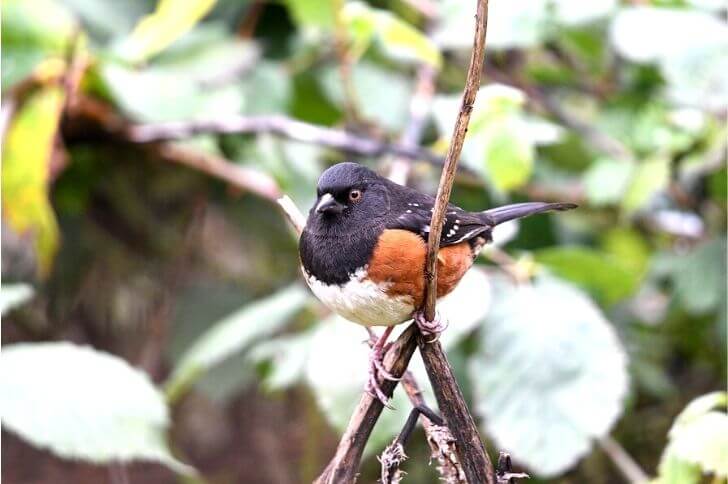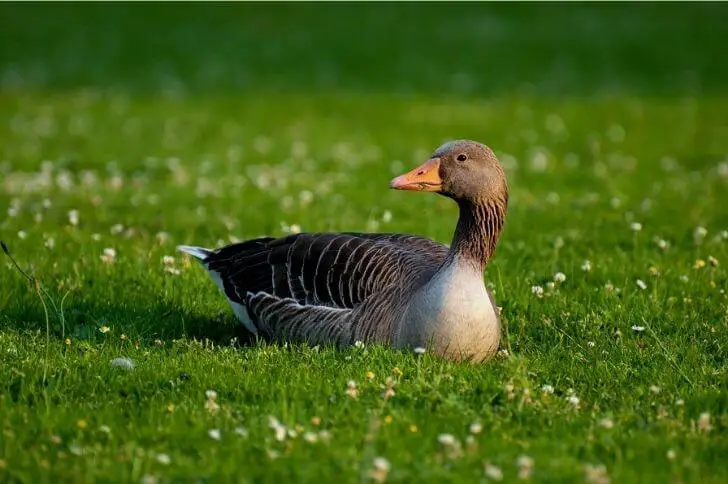Black birds with blue heads are a beautiful specimen of their kind. Besides the common grackle, there are a variety of other blue headed birds that we’ll look at in the article below. Some are found within the United States while others are resident breeders in other parts of the world.
We’ll look at their size, preferred habitat and more. So whether you are looking for local birds or are planning to go on a bird watching tour in some other corner of the world, this list is for you.
Black Birds with Blue Heads
1. Scarlet-thighed dacnis

source: adrielperezcr
Size:
Small and pretty. Scarlet-thighed dacnis are small, about 4 inches, birds. They are the same size as house sparrows. An adult weighs 0.5 oz.
Plumage:
Easy to identify. Scarlet-thighed dacnis have a black back with a turquoise colored head and nape. Their underparts are bluish-black while their feet are all gray. Pay close attention to the female; they are slightly different. They are more buffy with a turquoise head. Both sexes have red eyes and short, sharp black bills.
Habitat & facts:
Scarlet dacnis are small passerine bird endemic to South America. They prefer tropical broad-leaf forests where they forage for insects and fruit.
Their diet consists of 60% fruit and 40% insects. This bird species builds a small cup-shaped nest from moss, lichen, and grasses. The Scarlet-thighed Dacnis is a common bird in parts of its range.
2. Common grackles
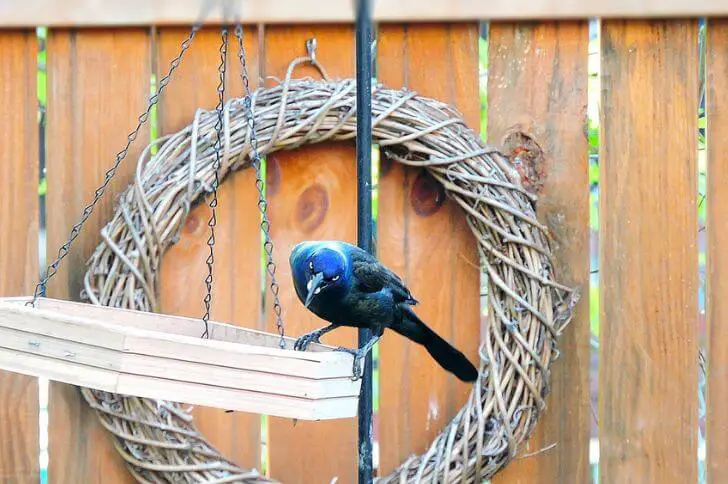
Size:
How long is a common grackle? These birds are not sexually dimorphic; males and females are almost the same size. An adult common grackle can measure 11 – 13 inches with a span of 14 – 18 inches, making them slightly larger than the red-winged blackbird. Also adult males weigh 4.3 oz while females are about 3.3 oz in weight.
Plumage:
How to identify common grackles? Color patterns are easy to identify. Be on the lookout for medium sized birds that have a bronzy-black look from far.
Their heads are purplish-blue. Females are duller. Both sexes have pale yellow eyes and dark feet. Note their thick black bills that you can read more about here. With the glossy black plumage, this bird is hard to miss.
Habitat & facts:
Where do common grackles live? They can be found all year round in some southeastern states, ranging from Florida to Georgia to South Carolina. Common grackles breed in the East of rocky mountains.
These blue headed blackbirds are found in swamps, marshes, forest edges, meadows, and open woodland. They are particularly common in areas where there is an abundance of food sources. Grackles will feed on just about anything from seeds to garbage to different fruit.
Where do common grackles breed? This blue head bird prefers to build nests near water with the female choosing the site. Also females build the nests with males lending a bill once in a while. This activity can take up to 6 weeks.
Their clutch consists of 1 – 7 eggs. The eggs can be dark brown, whitish or light blue and they hatch after three weeks.
Grackles are considered to be nuisance birds because they can be aggressive towards other animals and people, as well as noisy and destructive.
3. Tree swallows
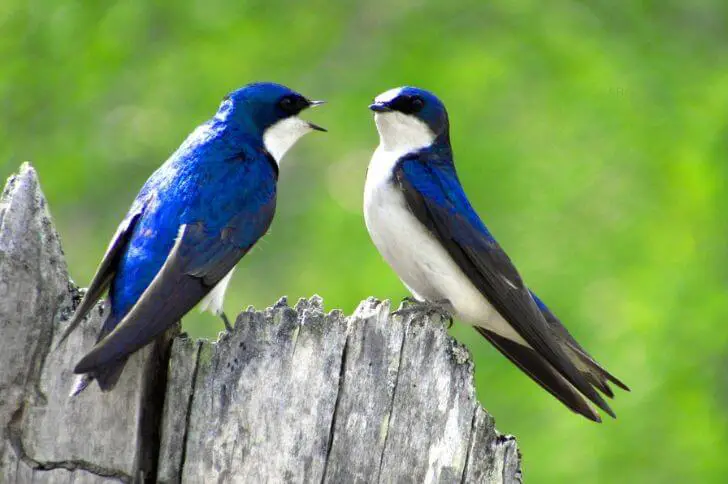
Size:
Found all over the United States, Tree swallows are small birds that measure 4.7 – 5.5 inches, making it smaller than purple martins. On average an adult boasts of a 11.8 -13.8 inches span and 0.8 in weight.
Plumage:
Though not all black, we included it on this list because of its unique combo, black and blue. These birds have blue upperparts with black wings and white below. Juvenile females have black upperparts with hints of green-blue.
Habitats & facts:
This North American songbird is one of the most common swallows. It can be found in a variety of habitats, including forests, fields, and wetlands. These birds are known for their aerial acrobatics and for their skill at catching insects in flight.
Tree swallows build nests out of mud and grasses, typically attaching them to the underside of a bridge or overhang. These birds are monogamous and form strong pair bonds. The female lays 4-7 eggs, which the male incubates for about two weeks. Both parents then help to feed the chicks until they fledge about three weeks later.
How do you get tree swallows? Want to attract swallows in your yard? One of the best ways is by installing feeders and nest boxes.
Are tree swallows aggressive? Only when protecting their nesting areas from predators, then will you notice swallows being aggressive.
4. Blue-back grassquit

Size:
At about 4 inches in length, the blue-back grassquit is a dull bird that is almost the same size as a house sparrow. Adult grassquits weigh 0.33 oz.
Plumage:
Like other birds on this list, they spot blue heads with a black belly and back. Females have different color patterns; a streaked brown. Both sexes have short thick bills.
Habitat & facts:
Blue back grassquits are small passerine bird that range from Mexico to North Argentina. This species is common in open country with scattered trees and bushes. They are from the family thraupidae which includes other birds such as tanagers and honeycreepers.
This species feeds on seeds of grasses and other plants. It often forages in flocks. What are the songs of the blue-back grassquit? Mostly “jweee” calls. Nests are built by both sexes and are about 3 inches in diameter.
5. Purple sunbird

Size:
Small and unique. How big is the purple sunbird? About 4 inches from head to tail.
Plumage:
The breeding male is purplish-black with a small metallic blue head. Females have a dark brown back and whitish below. Young bird are yellow below and browinish above. All birds have long curved bills and dark feet. This sunbird species is slender.
Habitat & facts:
Purple sunbirds are a resident breeder in tropical southern Asia from India and Sri Lanka east to Indonesia and the Philippines. This sunbird is common in gardens, where it feeds on nectar from flowers.
Is the purple sunbird a hummingbird? Yes, they are part of the sunbird family. This species builds a cup-shaped nest of fine grasses hanging from a branch. Three to four eggs are laid which hatch in about 12 days. The young birds fledge after about 16 days.
6. Blue-black grosbeak

Size:
Usually seen in pairs, blue-black grossbeaks are 6.2 inch birds that are sexually dimorphic. This makes them larger than sparrow-sized.
Plumage:
Like the blue-back grassquit, the adult blue-black grosbeak male is a mix of blue and black. Females are dark brown. Both sexes have short triangular bills.
Habitat & facts:
Ranging from Mexico to Venezuela, these birds with blue heads are usually seen singly or in pairs, and they are known for their loud, melodious song. These birds eat insects and seeds, and they can be quite aggressive when protecting their territory.
When do blue-black grosbeaks breed? Egg laying takes place in the summer month. Their clutch is made up of 2 eggs.
Related Read: Learn about black birds with white beaks
7. Satin bowerbird
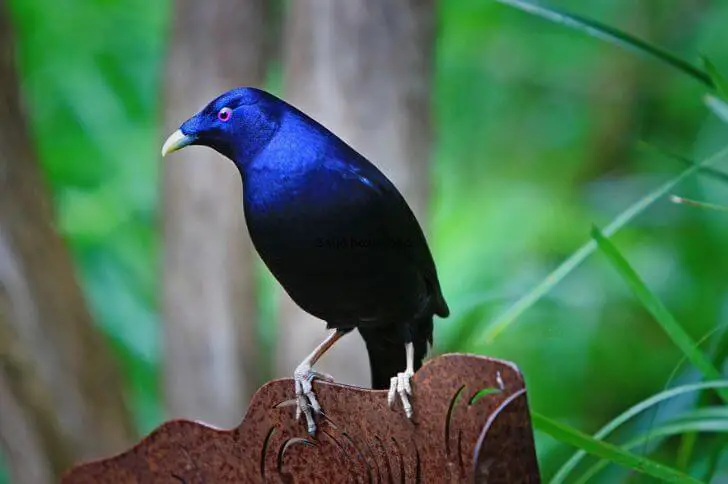
Size:
Large and loud, satin bowerbirds are beautiful birds found in parts of Australia. How long is a bowerbird? Adult males are about 13.8 inches and weigh 6 – 10 oz. Females are smaller weighing 5.8 – 9 oz.
Plumage:
Sexes are different making identification easy. Satin bowerbird males are blue-black with a gorgeous glossy look. Also note their stunning purple eyes and short pale bill. Females are a mix of green-brown with purple eyes.
Habitat & facts:
The satin bowerbird is well known for its bowers—ornate, ritualized structures made of sticks, twigs, and flowers that are used for courtship display. The male builds several bowers in his territory and decorates them with colorful objects such as berries, flowers, and shells. He performs an elaborate mating dance inside the bower to attract females.
Mating season starts from October – February. These birds with blue heads lay two to three streaked brown eggs that hatch after three weeks.
What do bowerbirds eat? Their diet consists of many plants such as European olive that they get by raiding agricultural fields. Young Ones feed on cicadas and beetles.
8. Purple martins

Size:
From north america east to the South, purple martins are popular birds found in most backyards. How big is this bird? In length about 7.5 – 7.9 inches, weighs 1.6-2.1 oz, and a span of 15.3-16 inches.
Plumage:
How to spot purple martins in your backyard? Be on the lookout for the male which is blue-black with a blue head. Females have lighter underparts, darker back, and a pale blue hue on their heads. Both sexes have slightly forked tails.
Habitat & facts:
Purple martins are the largest swallow in North America and are gregarious birds. They live in large numbers of hundred individuals.
Purple martins eat insects, which they capture in flight. They prefer flying insects such as mosquitoes, blackflies, and beetles, but will also eat bees, wasps, and hornets. They catch most of their prey while flying low over open areas such as fields or wetlands.
These birds with blue heads migrate south for the winter, typically spending the winter in South America. In the spring they return to North America to breed. They build their nests out of mud pellets on man-made structures such as gourds, birdhouses, or eaves of buildings.
9. Anjouan sunbird
Size:
Measuring between 3.5 – 6 inches, anjouan sunbirds are members of the nectariniidae family that includes other sunbirds and spiderhunters.
Plumage:
Males are mostly black with a glossy blue head. Females are a dull yellow. Both birds have sharp curved bills that come in handy when feeding.
Habitat & facts:
The Anjouan sunbird is endemic to the island of Anjouan, part of the Comoros archipelago. Their diet consists mainly of nectar from flowers, supplemented by insects. It is a gregarious species, typically occurring in small flocks.
10. Cassowary bird

Size:
Termed as the world’s most dangerous bird, cassowary is a large black bird with a blue head. How big are cassowary birds? An adult can stand up to 6ft high, weigh up to 130 lb, not forgetting their 4.7-inch sharp claws.
Plumage:
There are three types of cassowaries; southern cassowaries, northern cassowaries, and dwarf cassowaries. These birds have one thing in common; black bodies. Their heads are blue. To differentiate the species look at their necks.
Southern birds have a red wattle, Northern cassowaries have an orange-colored neck, while dwarf cassowaries are all blue.
Habitat & facts:
This large, flightless bird is native to the tropics of New Guinea and northeastern Australia. Cassowaries are omnivorous, and eat a variety of fruits, berries and fungi. They can run up to 30 miles per hour, and can jump up to six feet high. Cassowaries are considered dangerous animals, as they have been known to attack humans and other animals.
They favor mangrove stands and tropical forests. These solitary birds nest in spring.
12. Bulwer’s pheasant

Size:
Averaging 31 inches in length, bulwer’s pheasants are large black birds with blue heads. Females average 22 inches in length.
Plumage:
How to identify bulwer’s pheasants? Males have a beautiful snow-white tail, black body and a sky-blue head. The males facial skin droops down its breast. Females are mostly brown with very little blue facial skin.
Habitat & facts:
This is a bird in the pheasant family Phasianidae. It is found in forests and woodland edges in lowland and mountainous areas of Southeast Asia. These bird are uncommon due to habitat loss.
Also read: Black birds with Long necks
13. Crested fireback
Size:
Also a member of the pheasant family, the crested fireback is a 27.6 inch bird that is sexually dimorphic.
Plumage:
Males are blue black with sky blue skin on their head. Note the bright red eyes. Females are brown with a whitish streaked belly.
Habitat & facts:
The crested fireback is a ground-dwelling bird and spends most of its time foraging for food in the underbrush. It feeds on insects, small animals, and seeds. This black bird with a blue head is also known to eat fruit and berries. This bird is considered to be endangered due to habitat loss and hunting.
Other Black and Blue Birds
14. Indigo bunting
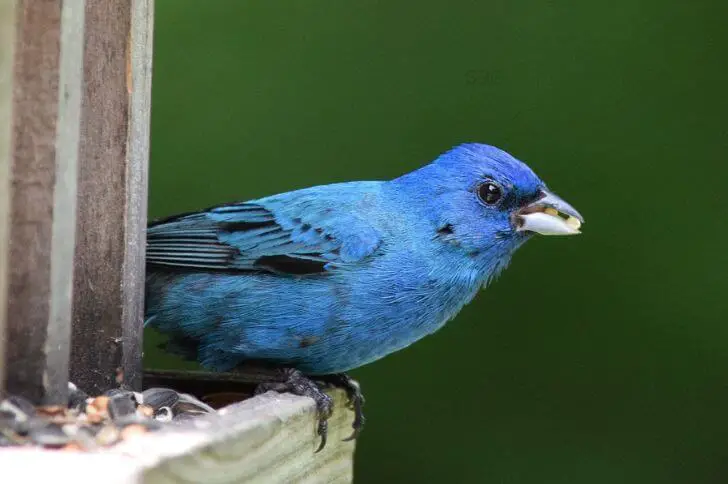
Indigo buntings are small passerine birds in the family cardinalidae which also includes northern cardinals. They are native breeders in North America, where they breed from southern Canada to central Mexico. It is migratory, winter months are spent in Central America and the West Indies.
The indigo bunting is a sprightly bird with a blue body and black wings. The sexes are different in appearance. Females are brown with lightly streaked breasts. This species feeds on insects and seeds.
The bird’s nest is a thin-walled cup of grass, leaves, and stems lined with fine grass or hair. 2-4 eggs are laid, and are incubated by the female for 12-14 days.
15. Black-billed Magpie
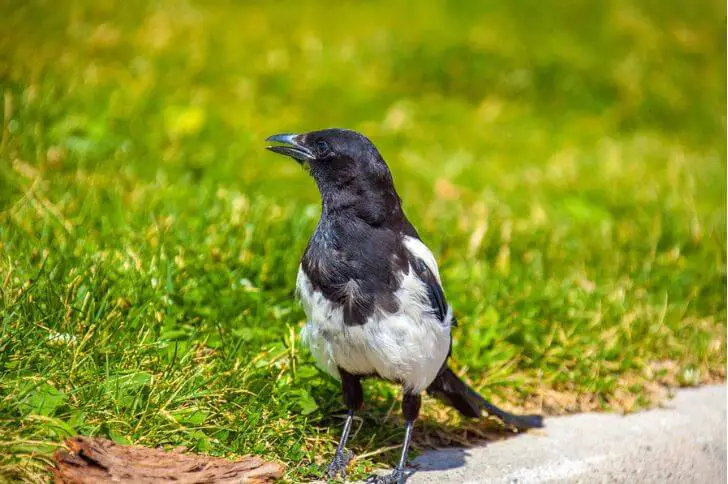
Black-billed Magpies or the American magpies are large, black, blue and white songbirds that are found in North America. These birds are omnivores and eat a variety of things, including insects, small mammals, berries, seeds, and carrion.
Magpies are known for their intelligence and their ability to learn quickly. They are also notorious for being thieves, and will often steal food from other animals or people. They breed in the springtime and build nests out of sticks and other materials.
The female lays between 2 and 9 eggs. Chicks hatch after about 3 weeks and are cared for by both parents. Magpies can live up to 20 years in the wild.
16. Asian-fairy bluebird
Asian-fairy bluebirds are small passerine birds found in open woodlands and gardens throughout much of eastern Asia. Adult males are bright blue on the back and black below. Their eyes are a bright red.
The Asian-fairy bluebird is a sociable species, often seen in small flocks or mixed-species feeding flocks. It feeds on insects, spiders, and fruit. The nest is a deep cup built from sticks and lined with grass or other soft materials, typically placed in a tree hole or cavity.
17. Steller’s jay
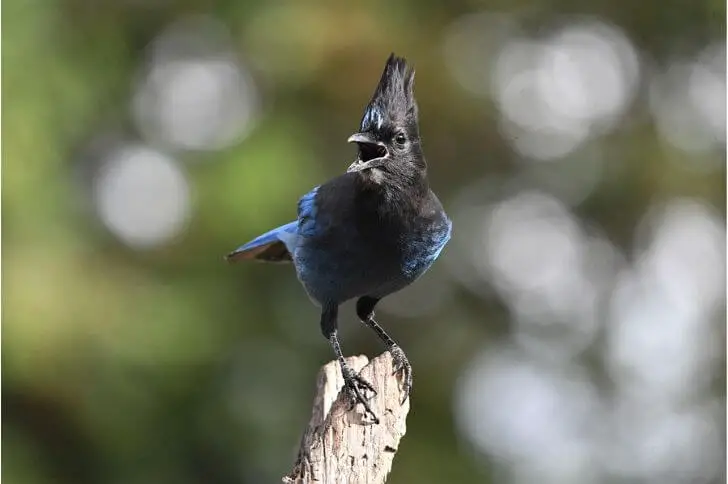
Steller’s Jay are beautiful birds that can be found in the western United States. They are blue with a black head. They are about 12 inches long and have a wingspan of about 17 inches. They eat insects, seeds, fruit, and nuts.
Steller’s Jays are very social birds and live in groups of 4-12 birds. They are cavity nesters and will use tree cavities, birdhouses, or even empty cars to nest in. The female steller’s jay lays 2-5 eggs. The chicks fledge when they are about 16 days old.
Hi, my name is Steve. My friend and I started the spanishbirdguides.com to share our passion with other like-minded people. So, if bird watching is your thing, you’ll love this blog. I’ll share what I’ve learnt about both local birds and those found in other parts of the world. Also, I’d love to hear your experiences.
